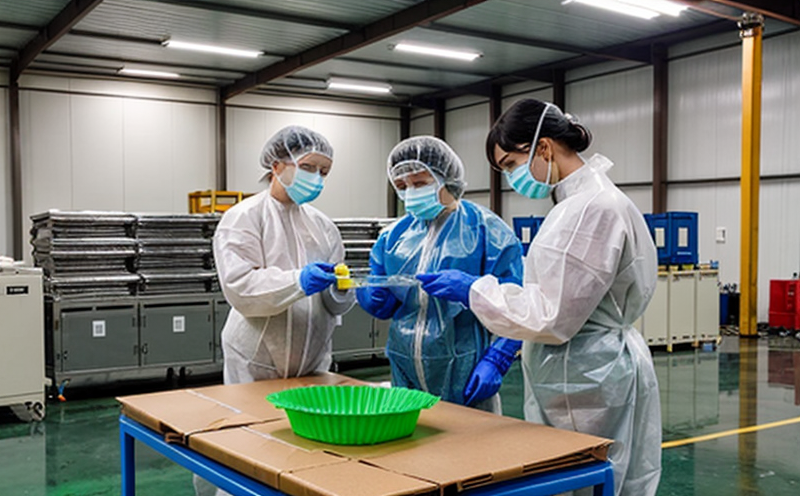ASTM D1790 Puncture Resistance Testing
The ASTM D1790 standard method is a critical procedure used to determine the puncture resistance of plastic packaging materials. This test evaluates how well the material withstands punctures, which is essential for ensuring that packages can protect contents from damage during transit and handling.
Plastic packaging plays a vital role in modern supply chains, providing protection, containment, and transportability. However, not all plastics are equally resistant to punctures. Some materials may tear or rupture under stress, leading to potential leaks or breaches in the package integrity. ASTM D1790 helps manufacturers identify which materials offer robust puncture resistance.
The test involves subjecting a specimen of plastic packaging material to controlled puncturing forces until failure occurs. The force at which the specimen fails is recorded and compared against industry standards or specified requirements. This information is crucial for quality assurance, regulatory compliance, and product development.
For instance, in the pharmaceutical sector, where integrity of containers is paramount, ASTM D1790 ensures that packaging materials meet stringent requirements to safeguard medication from contamination or degradation.
This testing method can also be applied in consumer goods industries, ensuring that packaging remains intact during typical handling and transport. The data generated from this test aids in selecting appropriate material types for different applications, balancing cost-effectiveness with performance expectations.
| Key Parameters | Description |
|---|---|
| Puncture Force | The force applied to the specimen until it fails. |
| Specimen Size and Shape | The dimensions used for testing, standardized according to ASTM D1790 guidelines. |
| Testing Environment | The conditions under which the test is conducted, including temperature and humidity. |
| Type of Puncture Tool | The specific tool or instrument used for puncturing the specimen. |
In summary, ASTM D1790 provides a standardized approach to assess plastic packaging materials' resistance to puncture. By adhering to this method, manufacturers can ensure that their products meet necessary safety and quality standards, thereby enhancing consumer trust and regulatory compliance.
Scope and Methodology
The ASTM D1790 standard outlines a precise methodology for determining the puncture resistance of plastic packaging materials. The test involves applying controlled forces to a specimen until it fails due to puncturing. This section will detail the key aspects of this process.
- Preparation of Specimen: A square or rectangular piece of the material being tested is cut according to ASTM D1790 specifications.
- Puncture Tool Setup: The puncture tool, designed for standardized testing, is calibrated and positioned over one corner of the specimen.
- Application of Force: Controlled forces are gradually applied until the material fails. The force at which failure occurs is recorded.
- Data Analysis: Results from multiple tests are averaged to provide a representative value for the puncture resistance of the material.
The scope encompasses various plastic packaging materials such as films, sheets, and laminates used in food packaging, pharmaceuticals, and consumer goods. The methodology ensures consistency and accuracy across different laboratories, facilitating comparability of results globally.
Why Choose This Test
Choosing ASTM D1790 Puncture Resistance Testing for plastic packaging is essential to ensure product integrity and compliance with industry standards. Here are several reasons why this test is crucial:
- Enhanced Product Safety: Ensures that packages can protect contents from physical damage during handling, shipping, and storage.
- Regulatory Compliance: Many industries have regulations mandating the use of puncture resistance tests for certain types of packaging materials.
- Quality Assurance: Provides a reliable method to assess material performance, helping manufacturers make informed decisions about their product design and production processes.
- Cost-Effective Solutions: By identifying suitable materials upfront, companies can avoid costly redesigns or recalls later in the development cycle.
In addition, ASTM D1790 is widely accepted by global standards bodies like ISO, ensuring that your test results are recognized and respected worldwide. This consistency aids international trade and collaboration among industries.
International Acceptance and Recognition
The ASTM D1790 Puncture Resistance Testing for plastic packaging materials is internationally accepted due to its rigorous methodology and widespread use across various sectors. Here are some notable points regarding its global acceptance:
- American National Standards Institute (ANSI): ASTM standards, including D1790, are recognized by ANSI as American National Standards.
- International Organization for Standardization (ISO): ISO 2836:1984 is a comparable standard that aligns closely with ASTM D1790 in terms of testing procedures and criteria.
- European Committee for Standardization (CEN): The European standard EN 12540 also provides a framework similar to ASTM D1790, ensuring compatibility across the EU.
- Australian Standards: AS/NZS 3867:2016 incorporates principles from ASTM D1790 in its testing procedures.
The widespread adoption of ASTM D1790 by these bodies underscores its importance and reliability. Laboratories accredited to conduct this test ensure that results are consistent with international standards, making them valuable for global trade and collaboration.





